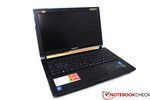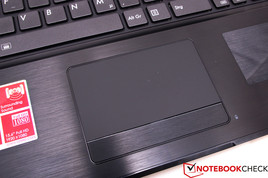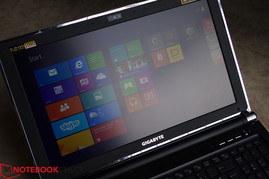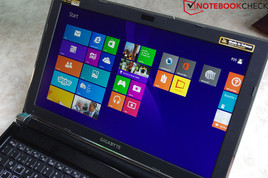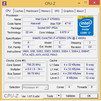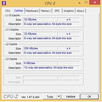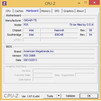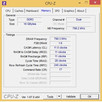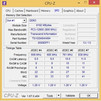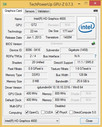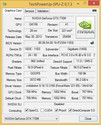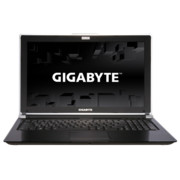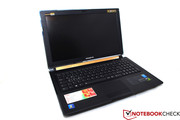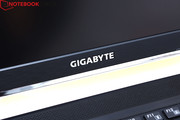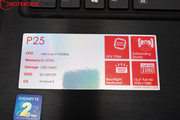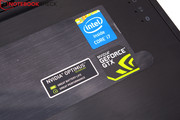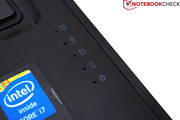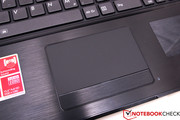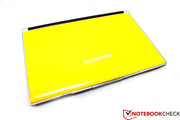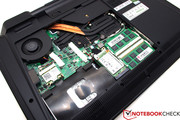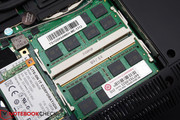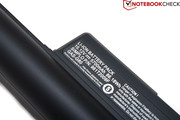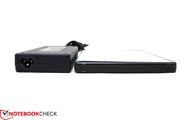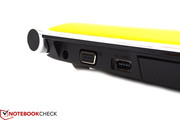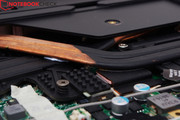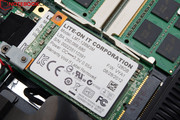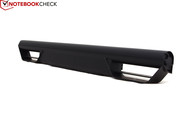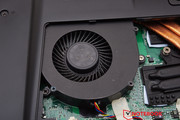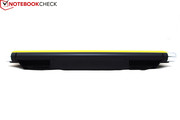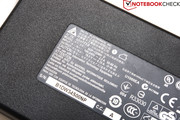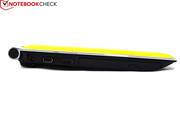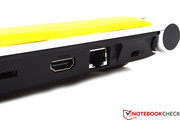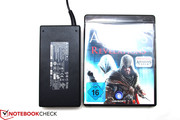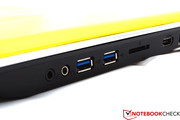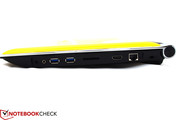Review Gigabyte P25W Notebook

For the original German review, see here.
A clear line management, zesty design, and plenty of power under the hood - but it's not a roadster. Gigabyte's P25W dishes up a unique look, and wants to particularly appeal to gaming hearts. The model sports a premium-range processor from Intel. The Core i7-4700MQ relies on four physical, and four logical cores. The well-known HD Graphics 4600 takes care of graphics output in idle mode. When it really gets down to business, the dedicated GeForce GTX 770M is also enabled via Nvidia's Optimus technology.
The working memory of 16 GB is generously sized, and allows many parallel applications. Windows 8.1 is the operating system installed, and is on two mSATA SSDs in a RAID 0 array. The gaming laptop's design is particularly striking, and immediately catches the eye with its bright yellow color.
Case
The casing of Gigabyte's P25W has a very marked design. Starting with its color up to the squarish and angular casing - a roadster was apparently used as the model. The display's upper side gleams in a glossy yellow hue that magically attracts fingerprints. The stiffness of the upper side is also not quite satisfactory because it can be dented easily.
Matching the bright color, Gigabyte's logo adorns the lid's center with glossy, chrome-colored letters. The lid's rim is also covered with the chrome-like color. However, it is not metal but simple plastic. Following the anti-glare screen, the bezel's finish is matte-black, and does not reflect light.
The casing is largely made of rigid plastic that is only interrupted by aluminum in the wrist rest area. The build is of a high standard. Unlike the other parts of the chassis, the wrist rest's brushed aluminum look is unobtrusive. A generously sized plastic cover that is secured with only one screw on the casing's underside enables accessing the hardware.
The hinges are a bit disappointing because they do not have a sufficient hold on the display, and cannot keep it firmly in one position. Just lifting the laptop causes the display to fall back to its widest opening angle. However, the P25W is also very easy to open with only one hand.
Connectivity
The interfaces of Gigabyte's P25W only cover the standards: two USB 3.0 ports, one eSATA/USB 2.0 combo, as well as one VGA and HDMI port. The manufacturer could have placed the right-handed USB ports more favorably because it is exactly on the level of an external mouse. Gamers will thus frequently collide with cords from peripherals here. Finally, the installed Blu-ray drive, eSATA, and VGA port are on the left.
Communication
Gigabyte's P25W uses Intel's Centrino Wireless-N 2230 module for wireless connections. It was not very convincing in the test. The wireless module usually presents a good range, but the connection in the P25W was often interrupted at a distance of approximately 6 - 7 meters. We could only measure a maximum speed of 75 - 90 Kbit/s when communication with the router was available (64 Mbit line). Connection buildups were no longer possible at a distance of 10 - 12 meters. We cannot say whether this was because the antenna is shielded too strongly or whether it was the Wi-Fi module itself.
Connections using the Gigabit Ethernet chip from Realtek (GBE Family Controller) are more reliable. The laptop is connected to the router with a cord, and thus prevents interruptions. A 1.3 megapixel webcam that provides an acceptable picture quality is available for video chats.
Accessories
There are not many accessories included with one driver DVD, and several manuals. Beyond that, the laptop only comes with the necessary 120 watt power supply, and an almost 460 gram 8-cell battery. There is no recovery DVD so the customer would have to create one when required.
Software
Windows 8.1 64-bit is installed for quick use. Gigabyte additionally installs a trial version of Microsoft's Office 365 on the laptop, which the buyer can test for 30 days. After that, the software has to be purchased for further use. A few programs from CyberLink are also included. For example, Blu-rays and DVDs can be played via PowerDVD 10.
Besides various useful programs, Gigabyte delivers the laptop with a few proprietary tools. One is the SmartManager, which caused major problems in the tests. Many settings can be made using this software, besides adjusting the screen's brightness, and fan's behavior and speed. However, the incorrect configuration of SmartManager can lead to a performance loss of over 50%. To achieve the full performance, the option Power Mode must be set to High Performance, which changes the internal energy-saving plan of Windows. It is also necessary to disable the option Smart Cooling. The CPU throttles extremely when these points are disregarded.
However, when Smart Cooling is disabled, the P25W ignores all energy-saving options, and the 15-incher consumes an unduly amount of power. Since the SmartManager is not even displayed in the tray area, it can be particularly confusing for inexperienced users who might possibly be surprised about the too low performance.
Warranty
Gigabyte includes a 24 month warranty on the P25W.
Input Devices
Keyboard
A chiclet keyboard with a white backlight is installed for gaming and typing. The keyboard features a special sensor that adapts the light's brightness according to the ambient light, which creates a more pleasant glow. The keyboard uses the entire surface, and the keys have an appealing layout. The arrangement is standard for a 15.6-inch laptop, and even users with large hands can use it decently. The arrow keys have to be mentioned because they have more room than in other devices. However, Gigabyte installs the number pad very close to the keyboard.
The texture of the single keys is also good for gaming purposes because the fingers adhere to them well, and do not slip off. The WASD keys feature a white rim that is not illuminated by LEDs, but quickly catch the eye for better localization.
Single functions have been mapped on the number row, and can be opened via the FN key as usual. It is also possible to enable and disable the keyboard light using the space bar. Also, shortcut keys for opening SmartManager or volume control are located beside the power button.
The drop of the single keys is short, but they feature a clear feedback. Writing long texts can be a bit fatiguing. However, the keyboard is ideal for gaming. The noise was not noticed adversely in normal use.
Touchpad
The mouse replacement in Gigabyte's P25W is a small, touch-sensitive area that is integrated into the wrist rest, and which is only separated from it slightly. The pad's sensitivity is very high in view of the resolution, and thus the mouse cursor's control is fast and accurate. Although the pad's surface is not dotted or rough, it is not sticky and does not smudge. The mouse key is a single, dedicated bar directly beneath the touchpad. Using it is a bit more difficult, and it provides a palpable feedback.
Display
Gigabyte's P25W has a 15.6-inch Full HD screen with a resolution of 1920x1080 pixels. The screen from LG Philips (LP156WF1) was used in Gigabyte's P2542G precursor, and is identical in both brightness and contrast. The maximum brightness of 347 cd/m² and averagely 316 cd/m² is compelling. The illumination of 87% is good but not perfect. Owing to the high base brightness, the decrease toward the sides is barely noticed unfavorably.
| |||||||||||||||||||||||||
Brightness Distribution: 87 %
Center on Battery: 347 cd/m²
Contrast: 551:1 (Black: 0.63 cd/m²)
ΔE Color 9.57 | 0.5-29.43 Ø5
ΔE Greyscale 11.71 | 0.57-98 Ø5.3
58.86% AdobeRGB 1998 (Argyll 1.6.3 3D)
62.1% AdobeRGB 1998 (Argyll 2.2.0 3D)
89.1% sRGB (Argyll 2.2.0 3D)
60.5% Display P3 (Argyll 2.2.0 3D)
Gamma: 2.54
Like in the P2542G, the black level is not quite satisfying, and only convinces to an extent with 0.63 cd/m². However, it has improved a bit compared with the precursor (0.74 cd/m²).
Besides the brightness, the contrast has not been changed, and exhibits a similar, good result with approximately 550:1. Some screens from other manufacturers achieve over 700:1, but the color reproduction is not as good. The colors look rich and balanced despite the matte surface.
However, Gigabyte's P25W is unsuitable for professional image editing because it only achieves AdobeRGB coverage of 59%. The gamma rate of 2.54 also deviates from the ideal of 2.2.
Performance
In addition to a gaming-suitable screen, the performance is a decisive point in a gaming laptop. Gigabyte relies on Intel's Core i7-4700MQ quad-core processor. It can address four virtual units via Hyper-Threading technology, which is beneficial for simultaneously running processes. The base clock is 2.4 GHz, but increases considerably during load. 3.3 GHz is possible when two cores are loaded. When an application uses only one processor core, it can reach up to 3.4 GHz via Turbo mode.
The integrated HD Graphics 4600 is responsible for graphics output in office and idle mode. The graphics chip clocks with 400 - 1150 MHz, and supports DirectX 11. Many of our benchmarks verify that the chip has an appealing performance. The dedicated graphics card is enabled via Nvidia's Optimus technology when higher graphics power is demanded.
Gigabyte installs the high-end GeForce GTX 770M card in the P25W for processing games. It clocks with 811 MHz, and like the processor, it can use a Turbo mode that boosts its performance to a maximum of 862 MHz. The manufacturer relies on a RAID 0 array comprised of two LiteOn SSDs for storage. A large 1000 GB mechanical HDD is installed for other data, such as videos and movies. The 16 GB working memory can be called generous and future-proof.
Processor
Intel's Core i7-4700MQ is the successor of the Core i7-3630QM, and has a slightly increased performance per clock. The quad-core processor worked satisfactorily in Gigabyte's P25W, and achieved a score of 6.75 points in the Cinebench R11.5 multi-CPU test. The identically configured DevilTech Fragbook DTX achieved a score of 7.00 points with the same processor model. This difference is lower in the single-core benchmark, where our review sample achieved 1.49 points in opposition to the 1.51 points that DevilTech's Fragbook DTX achieved.
When Smart Cooling was enabled in SmartManager, Gigabyte's laptop automatically throttled its clock, and only achieved approx. 3.5 points in Cinebench 11.5 multi-core operation. Gigabyte's P25W cannot use any energy-saving functions when the fan option is disabled, and processed the multi-CPU test even faster than in AC-mode with 6.89 points. The P25W accomplished identically low scores as in AC-mode when the Smart Cooling option was enabled.
| Cinebench R11.5 - CPU Multi 64Bit (sort by value) | |
| Gigabyte P25W | |
| Deviltech Fragbook DTX (MS-1763) | |
| Asus G750JH-T4080H | |
| SCHENKER XMG P723 | |
System Performance
Owing to the RAID array, the swift quad-core processor, and generous working memory, the Gigabyte P25W fights its way to the far top with 5840 points in PCMark 7. Both the One K56-3N2 (5935 points @ Core i7-4700MQ + GeForce GTX 780M) and Schenker XMG A523 (5944 points @ Core i7-4700MQ + GeForce GTX 765M) 15-inch gaming contenders are a bit faster. MSI's GS70 that relies on an SSD combo from Toshiba also only surpasses this marginally. This looks exactly the same in the storage test of the latest PCMark 8, which gave the P25W a very good score of 4938 points.
The benchmark scores reflect the subjective general performance. Programs start extremely fast, the system is ready-to-go within a few seconds, and working with multiple opened applications is possible without lags.
| PCMark 7 Score | 5840 points | |
| PCMark 8 Home Score Accelerated | 4032 points | |
| PCMark 8 Creative Score Accelerated | 5322 points | |
| PCMark 8 Work Score Accelerated | 4835 points | |
Help | ||
Storage Device
As mentioned above, Gigabyte uses two 120 GB mSATA SSDs from LiteOn. However, only about 100 GB is available in state of delivery because of the recovery partition, and a few installed programs. A large 1000 GB HDD is also available for storing videos, and other files.
It is not surprising that the RAID 0 array is lightning fast, and delivers top-notch sequential rates. With 852 MB/s in read, and 626 MB/s in write, the SSD combination achieved very high speeds in CrystalDiskMark. Only a few laptops, such as MSI's GS70 (965/820 MB/s) or MSI's GE60H (1050/724 MB/s) score better here.
Graphics Card
The HD Graphics 4600 takes care of image output when no computing-heavy program is being executed. This graphics chip saves power in battery mode, and can also render current games in low resolutions.
But maximum graphics enjoyment is only possible with the dedicated Nvidia GeForce GTX 770. The laptop switches unnoticed between the integrated and dedicated GPU via Nvidia's Optimus technology. The GeForce GTX 770M is a premium-range model that is based on the GK106 chip, and which is built in the 28 nm process by TSMC.
3DMark 11 recorded a good rate of 5369 points from our review sample, and places the P25W along with One's K73-3N at the top of this hardware array. For comparison: Toshiba's Qosmio X70-A-11R accomplished 4916 points with the same CPU/GPU configuration. It is the same in 3DMark 13's FireStrike benchmark, where the review sample achieved 3359 points.
The scores are just 50% as high due to throttling when the Smart Cooling option is enabled. The P25W only achieved a FireStrike score of 1400 points when the fan option is enabled, and is on par with normal multimedia laptops.
| 3DMark 06 1024x768 Score | 23917 points | |
| 3DMark 11 Performance | 5369 points | |
| 3DMark Ice Storm Standard Score | 89043 points | |
| 3DMark Cloud Gate Standard Score | 14795 points | |
| 3DMark Fire Strike Score | 3359 points | |
| 3DMark Fire Strike Extreme Score | 1657 points | |
Help | ||
Gaming Performance
What good is a premium-range laptop without compelling gaming performance? We asked ourselves this question during the first gaming benchmark runs while the Smart Cooling option was enabled. But one thing at a time. When the settings are selected properly in the P25W, it can achieve an attractive performance in various games. The review sample displayed Tomb Raider with an average of 98.5 frames per second in high presets (1366x768 pixels), which is on par with comparable laptops. The larger DevilTech Fragbook DTX achieved 99.8 fps, and the Ibuypower Valkyrie CZ-15 managed 96 frames per second. The laptop even coped satisfactorily with the ultra option (1920x1080 pixels) with approximately 43 fps.
A clear favorite of the P25W is BioShock Infinite. Our review sample retrieved a very good rate of 99.5 frames per second in high presets, and thus places itself before MSI's GT70 (97 fps), and Ibuypower's Valkyrie CZ-15 (95 fps). Only a few frames decide whether images are rendered smoothly or with stutters in the ultra presettings. The P25W is often far ahead of its contenders with a whole 38 frames per second, owing to the new driver. Neither the Ibuypower Valkyrie CZ-15 nor the MSI GT70 manage such a lag-free gameplay, both with just below 29 fps.
The laptop even copes with CPU-intense application with ease. Company of Heroes 2 demands a lot of power from the processor, and gives many laptops a hard time. The P25W managed a decent rate with 31.5 fps in high presets (1366x768 pixels).
As the saying goes, where there is light, there is also shadow. The review sample has a few afflictions. The biggest is again the SmartManager. The P25W could not achieve a lag-free rate in any of the named titles with an incorrect fan setting. Additionally, we had minor issues with the preinstalled 331.58 driver from Nvidia in Tomb Raider. The mouse only responded very hesitatingly in low resolutions, and could not be used accurately. This problem was first solved after updating to version 331.65.
We also received the message that the working memory was filled to capacity in every game, and that we should close the program. This fact did not have an impact on the performance, but the game frequently switched to the window mode, and could not be reset. This issue could be resolved by rebooting the system.
Besides that, we noticed that changing the resolution occasionally overrode the screen's calibration, which resulted in an intense bluish cast. Restarting the game again helped here.
| BioShock Infinite - 1920x1080 Ultra Preset, DX11 (DDOF) (sort by value) | |
| Gigabyte P25W | |
| SCHENKER XMG P703 | |
| Asus G750JX | |
| Tomb Raider - 1920x1080 Ultra Preset AA:FX AF:16x (sort by value) | |
| Gigabyte P25W | |
| SCHENKER XMG P703 | |
| Asus G750JX | |
| Deviltech Fragbook DTX (MS-1763) | |
| Company of Heroes 2 - 1920x1080 Maximum / Higher / High AA:High (sort by value) | |
| Gigabyte P25W | |
| Deviltech Fragbook DTX (MS-1763) | |
| low | med. | high | ultra | |
| Tomb Raider (2013) | 282.4 | 153.9 | 98.5 | 43.7 |
| BioShock Infinite (2013) | 178.9 | 122.9 | 99.5 | 37.9 |
| Company of Heroes 2 (2013) | 52.8 | 48.3 | 31.5 | 14.6 |
Emissions
System Noise
The SmartManager does provide a big advantage in noise emissions. Gigabyte's laptop remains on a tolerable level owing to the Smart Cooling option, but it also throttles extremely.
The P25W achieved a low idle rate of 31 dB(A), which is throughout respectable. However, it occasionally achieved a well-audible level of 35 dB(A).
Playing a DVD resulted in approximately 37 dB(A). It got really penetrating during full load: With approximately 51 dB(A), the laptop was very loud in the stress test. The device performed the simulated gaming test (first scene of 3DMark06) with an acceptable 40 dB(A).
Noise Level
| Idle |
| 31.4 / 32.1 / 34.6 dB(A) |
| DVD |
| 36.5 / dB(A) |
| Load |
| 39.6 / 50.8 dB(A) |
 | ||
30 dB silent 40 dB(A) audible 50 dB(A) loud |
||
min: | ||
Temperature
The temperatures only prove that the 15-inch laptop has a smart cooling system to an extent. The Core i7-4700MQ climbed to just below 100 °C in the stress test using Furmark and Prime95. The casing remained considerably cooler, although a maximum of 50 °C above the keyboard is not a top rate. The wrist rest was even agreeably cool during full load, which the maximum temperature of 36 °C confirmed.
The main reason for this is the dual-fan system, which transports the CPU's and GPU's waste heat separately out of the casing. The two fans are located in the laptop's rear area. Each chip also has its own heat pipe system, and can thus pass the heat that it produces to the fan.
The processor's high temperatures are only reached when Smart Cooling is disabled. However, when this option is enabled, the Core i7-4700MQ automatically throttles its clock rate, and the temperatures are lower.
(-) The maximum temperature on the upper side is 50.4 °C / 123 F, compared to the average of 40.4 °C / 105 F, ranging from 21.2 to 68.8 °C for the class Gaming.
(-) The bottom heats up to a maximum of 47.8 °C / 118 F, compared to the average of 43.2 °C / 110 F
(+) In idle usage, the average temperature for the upper side is 30.2 °C / 86 F, compared to the device average of 33.8 °C / 93 F.
(+) The palmrests and touchpad are reaching skin temperature as a maximum (35.9 °C / 96.6 F) and are therefore not hot.
(-) The average temperature of the palmrest area of similar devices was 28.9 °C / 84 F (-7 °C / -12.6 F).
Speakers
The P25W features a 4.1 system that is comprised of four speakers, and a subwoofer. Regrettably, neither the speakers nor the subwoofer are convincing. The speakers sound very tinny and shrill. Regardless whether playing metal, rock or hip-hop music, the sound system does not cause enthusiasm. Particularly the subwoofer is barely audible. The practical Dolby Digital Center with an equalizer, and a few auto-features cannot change much about that either.
Energy Management
Power Consumption
As appropriate for a premium-range laptop, the P25W consumes quite a bit of power. However, it is only 14 - 30 watts in idle owing to the graphics switching. The 15-incher consumed as much as 108 watts in the simulated gaming test via 3DMark06. Our stress test guzzled almost 133 watts from the outlet, which points at a very tightly sized power supply. The laptop consumed approximately 0.6 watts in standby.
| Off / Standby | |
| Idle | |
| Load |
|
Battery Runtime
A big 86 Wh battery with 8-cells and 5700 mAh supplies the P25W with enough power. Battery Eater's Reader's test confirmed this with a runtime of just short of 9 hours (minimum brightness). Internet research was possible for a good five hours using medium brightness. Gigabyte's laptop will play movies for about 3.5 hours with maximum brightness. Users who want to play a round should reconnect the laptop to the outlet after approximately 1.5 hours.
The SmartManager makes sense for battery runtime. The review sample achieved a load runtime of over 2 hours when Smart Cooling was enabled. However, the user will not have the full performance available then; but that is not a big issue when playing a DVD or Blu-ray.
Verdict
A 15.6-inch laptop with Full HD support, and plenty of power is an invitation for gaming on-the-go. The screen is very bright, and its color reproduction is very good. Alongside the moderate weight of 2870 grams, the P25W is perfectly suitable for mobile gaming. Other premium-range laptops often weigh far over 3.5 kilograms. Besides that, the configuration of an Intel Core i7-4700MQ, and a GeForce GTX 770M is very well-chosen. The casing also makes a high-quality impression.
However, a few minor issues became apparent during the tests, which were annoying in their sum. The proprietary SmartManager is a good idea for controlling energy settings, volume or screen brightness, but Smart Cooling nullifies everything that is appreciated in a modern laptop. Although the system runs with a fairly low noise when this feature is enabled, the performance is only on the level of a multimedia laptop. When Smart Cooling is disabled, the P25W is quite loud and warm due to its higher speed.
The laptop is a powerful gaming machine with a great screen, and decent battery runtimes when SmartManager is deleted, or the user comes to terms with it.


 Deutsch
Deutsch English
English Español
Español Français
Français Italiano
Italiano Nederlands
Nederlands Polski
Polski Português
Português Русский
Русский Türkçe
Türkçe Svenska
Svenska Chinese
Chinese Magyar
Magyar